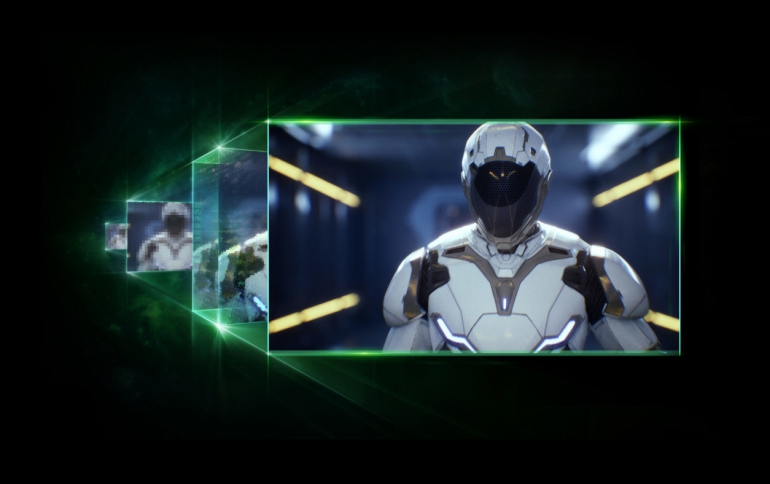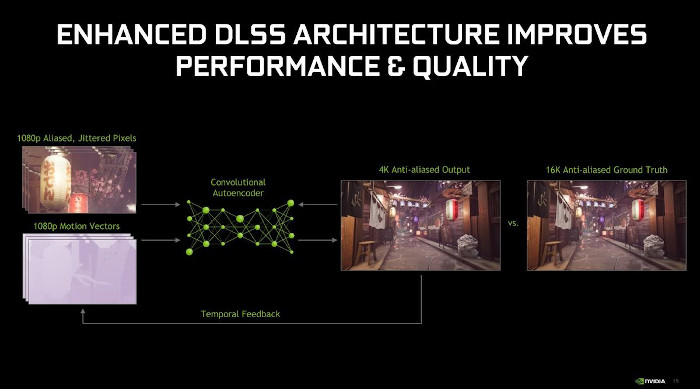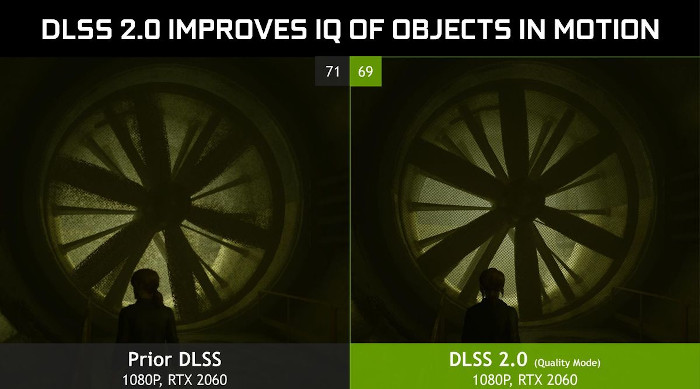
NVIDIA Could Revolutionize Gaming With DLSS 2.0
NVIDIA announced DLSS 2.0 on Monday, taking its revolutionary Deep Learning Super Sampling (DLSS) technology to the next level.
DLSS 2.0, releasing this week in Control and MechWarrior 5: Mercenaries, represents another major advance for AI in gaming.
Powered by dedicated AI processors on GeForce RTX GPUs called Tensor Cores, DLSS 2.0 is an improved deep learning neural network that boosts frame rates while generating beautiful game images.
It gives gamers the performance headroom to maximize ray tracing settings and increase output resolutions.
DLSS 2.0 offers several enhancements over the original version:
- Image Quality — DLSS 2.0 offers image quality comparable to native resolution while only having to render one quarter to one half of the pixels. It employs new temporal feedback techniques for sharper image details and improved stability from frame to frame.
- Scaling Across All RTX GPUs and Resolutions — a new AI model more efficiently uses Tensor Cores to execute 2x faster than the original, improving frame rates and removing restrictions on supported GPUs, settings and resolutions.
- One Network for All Games —The original DLSS required training the AI network for each new game. DLSS 2.0 trains using non-game-specific content, delivering a generalized network that works across games. This means faster game integrations, and ultimately more DLSS games.
- Customizable Options — DLSS 2.0 offers users three image quality modes (Quality, Balanced and Performance) that control render resolution, with Performance mode now enabling up to a 4x super resolution. (i.e. 1080p → 4K). This means more user choice, and even bigger performance boosts.
DLSS 2.0 uses a “fundamentally different” AI model that Nvidia claims is twice as fast as before. It accumulates data from multiple frames over time to generate its high-quality output frame, then feeds that frame back into the model to help inform the next frame. This increases the amount of data going into the AI model, which helps Nvidia generate much higher-quality images. In addition, the company can use a universal network for DLSS 2.0, rather than requiring per-game training.

DLSS 2.0 is twice as fast as the original, NVIDIA says. Not only does that improve frame rates, but it eliminates the need for those aggravating resolution restrictions so common in DLSS 1.0 games.

DLSS 2.0 will offer three quality modes, based around varying levels of image upscaling. Performance mode uses a 4X image upscale to spit out frames even faster, while Quality mode dials that back to a 2X upscale for optimal visuals. Balanced mode splits the difference.
The technology can even make fine details appear more crisp than native rendering thanks to the way the upscaling works, as shown below in Quality mode. DLSS 2.0 is also much better at rendering objects in motion.

In addition to Control and MechWarrior 5, DLSS 2.0 has delivered big performance boosts to Deliver Us The Moon and Wolfenstein: Youngblood.
DLSS 2.0 is now also available to Unreal Engine 4 developers through the DLSS Developer Program that will accelerate deployment in one of the world’s most popular game engines.
DLSS is one of several major graphics innovations, including ray tracing and variable rate shading, introduced in 2018 with the launch of the NVIDIA RTX GPUs.
NVIDIA says that more than 15 million NVIDIA RTX GPUs have been sold, and that more than 30 major games have been released or announced with ray tracing or NVIDIA DLSS powered by NVIDIA RTX.
That momentum continued with Microsoft’s announcement last week of DirectX 12 Ultimate, as well as NVIDIA RTX Global Illumination SDK, new tool support for the Vulkan graphics API, and new Photoshop texture tool plugins.
The NVIDIA RTX Global Illumination SDK, also released Monday, gives developers a scalable solution to implement ray-traced indirect lighting in games while still achieving performance targets.
The RTX GI SDK is supported on any DirectX raytracing-enabled GPU. It’s a starting point to bring the benefits of ray tracing to more games.
NVIDIA also Monday added support for the Vulkan graphics API to two of its most popular game development tools.
Nsight Aftermath, which provides precise information on where GPU crashes occur and why, is now available for the first time for Vulkan.
The NVIDIA Texture Tools Exporter allows users to create highly compressed texture files that stay small on disk and in memory.
It allows game and app developers to use higher quality textures in their applications, and provides users a smaller, faster, download size.
It’s available as a standalone tool or as an Adobe Photoshop plug-in for game developers and texture artists.




















